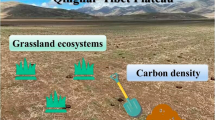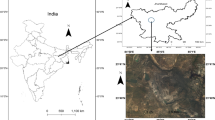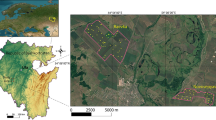Abstract
The development of fertility of soils on different parent rocks is considered for different types of spruce forests in the Khibiny Mountains. The spruce forests of Mts. Kuel’por, Vud’yavrchorr, Chil’mana, and Saami were the objects for the study. The results showed that the fertility level of the soils of the Khibiny Mountains was determined by the combined influence of the parent rock’s composition and the vegetation. The differences in the soil properties are mainly explained by the composition of the parent rocks. The pod-burs differ from the podzols by the higher contents of organic matter, nitrogen, and available nutrients. The podzols are the most acid soils there. The podburs of Mt Kuel’por developing on base-rich parent rocks are the most fertile. The differences in the fertility of the soils on the intrabiogeocenotic (tessera) level are related to the vegetation. The soils of the spruce and tall-grass tesseras are richer in nitrogen, calcium, and manganese as compared to the soils of the dwarf shrub-green moss, low-grass-dwarf shrub-green moss, and tussock grass-dwarf shrub tesseras.
Similar content being viewed by others
References
S. A. Barber, Soil Nutrient Bioavailability: A Mechanistic Approach (J. Wiley & Sons, NY, 1995).
N. P. Belov and A. V. Baranovskaya, Soils of Murmansk Oblast (Nauka, Leningrad, 1969) [in Russian].
A. S. Vladychenskii, N. O. Kovaleva, and Yu. M. Kosareva, “Mineralogy and Bulk Elemental Composition of Soils in U-Shaped Glacial Valleys of the Khibiny Mountains,” Dokl. Ekol. Pochvoved. 1(1), 1–19 (2007) (http://soilinst.msu.ru).
A. V. Galakhov, Petrology of the Khibiny Alkaline Massif (Nauka, Leningrad, 1975) [in Russian].
T. T. Gorbacheva, N. V. Lukina, and N. A. Artemkina, “Dynamics of the Contents of Polyphenols upon the Decomposition of Plant Falloff and Litter in Moss Spruce Stands of the Kola Peninsula,” Lesovedenie, No. 3, 15–23 (2006).
O. B. Dudkin, F. P. Minakov, M. P. Kravchenko, et al., Carbonatites of the Khibiny Mountains (Izd. KF, Apatity, 1984) [in Russian].
N. V. Dylis, “The Structure of Forest Biogeocenoses,” Komarovskie Chteniya 21 (1969).
E. N. Ivanova and N. A. Koposova, Soils of the Khibiny Tundra (Izd. Akad. Nauk SSSR, Moscow, 1937), Vol. 2 [in Russian].
V. B. Il’in, Heavy Metals in the Soil-Plant System (Nauka, Novosibirsk, 1991) [in Russian].
L. O. Karpachevskii, Variegated Soil Cover Pattern in Forest Biogeocenoses (Izd. Mosk. Gos. Univ., Moscow, 1977) [in Russian].
L. O. Karpachevskii, T. A. Zubkova, L. N. Tashninova, and R. N. Rudenko, “The Soil Cover and Parcellar Pattern of the Forest Biogeocenosis,” Lesovedenie, No. 6, 107–113 (2007).
N. V. Lukina, T. T. Gorbacheva, V. V. Nikonov, and M. A. Lukina, “Spatial Variability of Soil Acidity in Al-Fe-Humus Podzols of Northern Taiga,” Eur. Soil Sci. 35(2), 144–155 (2002).
N. V. Lukina and M. A. Orlova, “The Nutrient Regime of Old-Age Forests in the Kola Peninsula,” Lesovedenie, No. 1, 3–13 (2008).
N. V. Lukina, M. A. Orlova, and L. G. Isaeva, “Fertility of Forest Soils as the Basis of the Soil-Plant Interactions,” Lesovedenie, No. 5, 45–56 (2010).
N. V. Lukina, L. M. Polyanskaya, and M. A. Orlova, The Nutrient Regime of Northern Taiga Stands (Nauka, Moscow, 2008) [in Russian].
N. V. Lukina, T. A. Sukhareva, and L. G. Isaeva, Technogenic Degradation and Restoration Successions in the Northern Taiga Forests (Nauka, Moscow, 2005) [in Russian].
M. M. Mazyro, Soils of the Khibiny Mountains (Izd. Akad. Nauk SSSR, Moscow, 1936), Vol. 1 [in Russian].
K. N. Manakov and V. V. Nikonov, “Regularities of the Biological Turnover of Mineral Elements and Soil Formation in Biogeocenoses of Three Altitudinal Vegetation Zones,” in Soil Formation in Biogeocenoses of the Khibiny Mountains (Izd. Kol’sk. fil. Akad. Nauk SSSR, Apatity, 1979), 65–94 [in Russian].
K. N. Manakov and G. I. Ushakova, “The Composition of Organic Matter in Soils of the Khibiny Massif,” in Organic Matter in Soils of the Kola Peninsula (Izd. Kol’sk. fil. Akad. Nauk SSSR, Apatity, 1975), 69–75 [in Russian].
V. V. Nikonov, Soil Formation at the Northern Limit of Pine Biogeocenoses (Nauka, Leningrad, 1987) [in Russian].
V. V. Nikonov and N. V. Lukina, “The Effect of Spruce and Pine on the Acidity and Composition of Aerial Precipitates in the Northern Taiga Forest of an Industrial Region,” Ekologiya 31(2), 82–90 (2000).
V. V. Nikonov and V. N. Pereverzev, Soil Formation in the Kola Subarctic (Nauka, Leningrad, 1989) [in Russian].
D. S. Orlov, Soil Chemistry (Izd. Mosk. Gos. Univ., Moscow, 1985) [in Russian].
M. A. Orlova, N. Lukina, and V. V. Nikonov, “The Effect of Pine on the Spatial Variability in the Acidity of Podzols in the Northern Taiga Forests,” Lesovedenie, No. 6 (2003).
V. N. Pereverzev, N. S. Alekseeva, and O. I. Polyakh, “On the Role of the Texture of Parent Materials on the Formation of Soil Humus Profiles,” in Soil Studies in the Kola Peninsula (Izd. Kol’sk. fil. Akad. Nauk SSSR, Apatity, 1976), 60–74 [in Russian].
V. V. Ponomareva, “Materials on the Study of Organic Matter in Soils of the Khibiny Mountains,” Tr. Kol’sk. Bazy Akad. Nauk SSSR, No. 5, 5–30 (1940).
V. V. Ponomareva, Theory of Podzolization Process (Biochemical Aspects) (Nauka, Moscow, 1964 [in Russian].
E. M. Samoilova, Soil-Forming Rocks (Izd. Mosk. Gos. Univ., Moscow, 1983) [in Russian].
T. A. Sokolova, T. Ya. Dronova, D. B. Artyukhov, N. L. Korobova, A. P. Pakhomov, I. I. Tolpeshta, “Field Simulation of the First Stages in Interaction between Acid Precipitation and Forest Soils,” Eur. Soil Sci. 29(7), 783–791 (1996).
O. A. Fomicheva, L. M. Polyanskaya, V. V. Nikonov, et al., “Population and Biomass of Soil Microorganisms in Old-Growth Primary Spruce Forests in the Northern Taiga,” Eur. Soil Sci. 39(12), 1323–1331 (2006).
N. L. Chepurko, Biological Productivity and the Turnover of Elements in Forest and Tundra Communities of the Khibiny Mountains (Nauka, Leningrad, 1971) [in Russian].
B. Berg, “Litter Decomposition and Organic Matter Turnover in Northern Forest Soil,” For. Ecol. Managem. 133, 13–22 (2000).
B. Berkvist and L. Folkeson, “The Influence of Tree Species on Acid Deposition, Proton Budgets and Element Fluxes in South Sweden Forest Ecosystems,” Ecol. Bull. 44, 90–99 (1995).
D. Binkley and Ch. Giardina, “Why Do Trees Affect Soils? The Warp and Woof of Tree-Soil Interactions,” Biogeochemistry 42, 89–106 (1998).
K. Cromack, W. C. Graustein, K. Speidel, A. W. Todd, G. Spycher, C. Y. Li, and R. L. Todd, “Calcium Oxalate Accumulation and Soil Weathering in Mats of Hysterangium crassum,” Soil Biol. Biochem. 11, 463–468 (1979).
O. Halonen, H. Tulkki, and J. Derome, “Nutrient Analysis Methods,” Metsantutkimuslaitoksen tiedonantoja 121, 1–28 (1983).
S. E. Hobbie, “Effects of Plant Species on Nutrient Cycling,” Trends Ecol. Evol. 7, 336–339 (1992).
H. Jenny, “Role of the Plant Factor in the Pedogenic Functions,” Ecology 39(1), 5–16 (1958).
C. G. Jones, J. H. Lawton, and M. Shachak, “Organisms as Ecosystem Engineers,” Oikos 69, 373–386 (1994).
I. Kamayev, L. Rybalov, and N. Lukina, “Long-Term Dynamics of Earthworms in Forest-Tundra Ecotones in the Khibiny Mountains, Kola Peninsula, Russia,” in Understanding Circumpolar Ecosystems in a Changing World: Outcomes of the International Polar Year (November 3–6, 2010), (Univ. of Alberta, Edmonton, Canada, 2010).
G. Lovett, “Atmospheric Deposition and Canopy Interactions of Nitrogen,” in Atmospheric Deposition and Forest Nutrient Cycling, Ed. by D. Johnson and S. Lindberg (Springer-Verlag, NY, 1992), 152–165.
Methods for Integrated Monitoring in the Nordic countries (Nordic Council of Ministers, Nord, 1989).
T. Nasholm, A. Ekblad, A. Nordin, R. Giesler, M. Hogberg, et al., “Boreal Forest Plants Take Up Organic Nitrogen,” Nature, 914–916 (1998).
B. Nihlgard, “Pedological Influence of Spruce Planted on Former Beech Forest Soils in Scania, South Sweden,” Oikos, 195–207 (1971).
J. E. Peck, Multivariate Analysis for Community Ecologists: Step-by-Step using PC-ORD. (MjM Software Design, Gleneden Beach, OR, 2010).
D. J. Read and Peter-Moreno, “Mycorrhizas and Nutrient Cycling in Ecosystem—a Journey towards Relevance?” New Phytol. 157, 475–492 (2003).
Author information
Authors and Affiliations
Additional information
Original Russian Text © M.A. Orlova, N.V. Lukina, V.E. Smirnov, D.A. Krasnov, I.O. Kamaev, 2012, published in Pochvovedenie, 2012, No. 6, pp. 682–695.
Rights and permissions
About this article
Cite this article
Orlova, M.A., Lukina, N.V., Smirnov, V.E. et al. Fertility of soils under spruce forests of the Khibiny Mountains. Eurasian Soil Sc. 45, 612–624 (2012). https://doi.org/10.1134/S1064229312060087
Received:
Published:
Issue Date:
DOI: https://doi.org/10.1134/S1064229312060087




